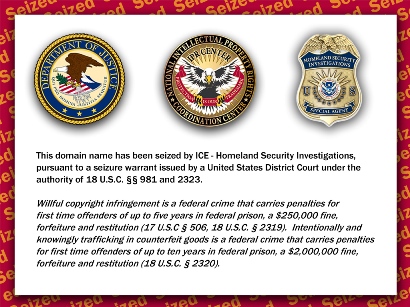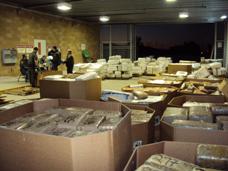Indicted on Mail Fraud, Wire Fraud, Other Charges
WASHINGTON—Charles Ike Emor, a/k/a Charles Ike Emenogha, 50, the founder and former executive director of SunRise Academy, a non-profit special education institution, has been indicted by a federal grand jury on charges that he stole more than $2.4 million in government money meant to serve needs of students. Among other things, Emor used the money for properties, cars, electronics, jewelry, and other personal expenses, the indictment states.
The indictment was announced by Ronald C. Machen Jr., U.S. Attorney for the District of Columbia; James W. McJunkin, Assistant Director in Charge of the FBI’s Washington Field Office; and Charles J. Willoughby, Inspector General for the District of Columbia.
“Tax dollars earmarked for schools are intended to buy textbooks, not luxury vehicles and diamond jewelry,” said U.S. Attorney Machen. “This indictment charges Charles Emor with stealing funds intended to benefit our children’s education.”
“This complex fraud scheme, which was investigated jointly by the FBI and the D.C. Office of Inspector General, involved the misappropriation of funds that were intended to assist District residents who needed help,” said Assistant Director in Charge McJunkin.
The indictment was unsealed today in the U.S. District Court for the
District of Columbia. It includes 10 counts of mail fraud, 13 counts of wire fraud, two counts of interstate transportation of stolen property, one count of theft from a program receiving federal funds, nine counts of money laundering, one count of first degree theft, and one count of first degree fraud.
If convicted, Emor faces a maximum sentence of 20 years in prison and a $ 250,000 fine. Under the advisory United States Sentencing Guidelines, the range of imprisonment is presently 70 to 87 months.
According to the indictment, Emor was the founder, president, and executive director of
SunRise Academy, a non-profit company that he started in 1999 to educate male students, aged 7 through 22, with emotional disturbances and learning disabilities.
SunRise had two separate campuses in
Northwest Washington, D.C. The Intermediate Campus was for males aged 7 through 15, and the SunRise Thurgood Marshall campus was for males aged 14 through 22.
SunRise students did not pay any tuition to attend the school. Rather, tuition and related services was provided to
SunRise by public money. The amount of funding that
SunRise received from D.C. Public Schools (“DCPS”) and the Office of the State Superintendent of Education ("OSSE") depended upon the number of students attending
SunRise.
DCPS and the OSSE relied upon SunRise to report enrollment information honestly and accurately to ensure that it received the appropriate amount of reimbursement funding for tuition and related services that it provided to District of Columbia students with emotional and learning disabilities. From October 2005 through July 2010,
SunRise was paid over $30 million of public funds to provide educational and related services for children with disabilities.
In June 2008, Emor created a for-profit company called Core Ventures, LLC. Emor owned 100 percent of the shares in Core Ventures. The purported purpose of Core Ventures was "consulting new businesses on how to set up their [business] plans, etc."
>From in or about January 2006 through in or about November 2010, Emor, aided and abetted by others, engaged in a scheme to defraud the government and to obtain public money, through SunRise, from DCPS and the OSSE, for his own use and benefit, and for the use and benefit of his friends and relatives, the indictment alleges. Among other things, Emor, through various misrepresentations and omission of material facts, induced DCPS and the OSSE to pay
SunRise money for tuition and related services for special education students who were either truant, incarcerated, hospitalized, attended other schools, or otherwise dropped out.
According to the indictment, Emor used the public money to pay his personal expenses that were entirely unrelated to support the education of students with disabilities at
Sunrise. These personal purchases included, but were not limited to, the payment of rent for the mother of his children in Upper Marlboro, Maryland; the payment of college tuition for his adult son; expensive jewelry; luxury watches; artwork; televisions and other electronic gadgets; custom-made clothing, and luxury vehicles, totaling in excess of $470,000.
Also, from March 2009 through January 2010, Emor transferred approximately $2 million from
SunRise to his company, Core Ventures, the indictment states. He then created, or caused the creation of bogus SunRise Board of Director resolutions and Board meeting minutes that purportedly authorized SunRise to “lend” the $2 million to Core Ventures for the purposes of "operating a coffee shop" to employ SunRise students. The terms of the loan was never reduced to writing. Emor, his adult son, and a
SunRise employee authorized the so called loan.
The indictment notes that OSSE revoked
SunRise’s Certificates of Approval following the issuance of a report in May of 2010 that reviewed programs, policies and procedures.
The indictment includes a forfeiture allegation seeking all proceeds obtained through the scheme. Among other things, it seeks a money judgment of more than $2.4 million as well as bank accounts and a Lexus automobile registered to Core Ventures.
The case is being prosecuted by the United States Attorney’s Office for the
District of Columbia and was investigated by the FBI’s Washington Field Office, the D.C. Office of the Inspector General and other federal agencies. The investigation is ongoing.
An indictment is merely a formal charge that a defendant has committed a violation of criminal laws and is not evidence of guilt. Every defendant is presumed innocent until, and unless, proven guilty.











